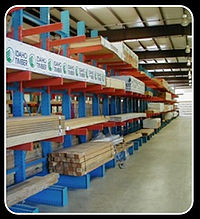Storage Racks Systems
Storage Racks Systems also known as furniture racks are ideal for storing long items in continuous runs to avoid left to right vertical uprights interfering with the placing product on the shelf. Because storage rack systems offer no vertical obstruction it allows for maximum storage. This arm rack system is ideal for storing non uniform products such as: furniture, building materials, sheet metal, heavy duty metals, pipe, bar stock, appliances, rugs and much more. Cantilever racks are manufactured from both roll formed steel and structural steel.
Typical Advantages
- Reducing labor costs in the stocking and selecting of goods
- Reducing damaged goods by storing them in the type racking designed for that product
- Postponing the need to expand or move by maximizing the storing efficiency of your current space
Components
Bases
Bases are the base of the cantilever system anchoring the rack system to the floor and providing support to the column or upright tower. The size of the base on a cantilever unit is dependent on the size of the arms and also the capacity of the rack.
Columns (Upright Towers, Verticals)
Frame columns mount into the base of the cantilever providing support to the arms that connect to the column. Columns can range in height and capacity depending on the application demands.
Arms
Cantilever arms are what support the product on the rack system. There are many different styles and capacities for these arms making cantilever rack systems fairly custom for each application. Arms can vary in capacity. be straight, be inclined, and have welded end lips.
Bracing (Horizontal and Diagonal)
Offer stabilization to the cantilever rack system. The widths and lengths of these braces are determined by the size of the product being stored and the application for which the system is being designed for.
Typical Features
- Load Deflection is the amount of product sagging between the load arms.
- Arm capacity is determined for evenly distributed loads.
- Upright capacity is determined by multiplying the capacity of each arm times the number of arms for each upright column.
- Arm capacity is determined by finding the total weight of each product level needed and dividing that number by the amount of arms for that product level.
- Arm capacity is based on an evenly distributed loads front to back and right to left.
- With two upright columns the distance between the cantilever arms should be half of the product or items length giving 1/4 over hang on each side.
- For three upright columns the distance between the cantilever arms should be one third of the product length offering one sixth over hang of the product.
- Cantilever rack is available in both single and double sided units offering maximum use of warehouse space.
Video
